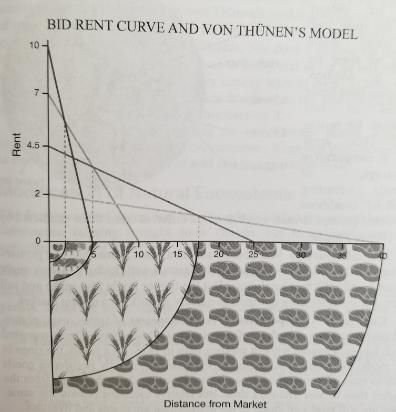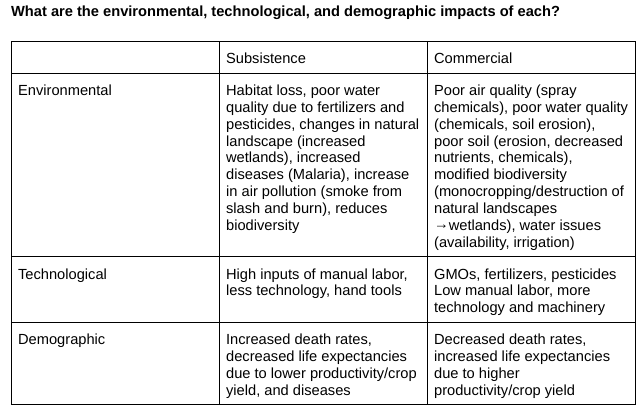Chapter 9 Agriculture Topics
}}Von Thunen}}
Links
https://docs.google.com/document/d/1vddz61UVXtIwMDV2eYuVJ8Xp4VQLI-x8S92e7Gn4ies/edit
Rings: Product + Why

1: Closest to City - Intensive Farming/Dairying
Dairy cattle, Strawberries, Eggs, Lettuce, Tomatoes, Broccoli, Apples, Fruits, Vegetables
Without refrigeration, they need to be brought to the market quickly. They are near the city for convenient access
2: Forest
Wood, Lumber
It is heavy and difficult to transport, so it’s near the city to reach the market quickly
3: Extensive Feild Crops
Field Corn, Soybeans, Wheat, Grains
These crops are light and don’t spoil quickly, so it’s easy to transport and has no rush to reach the market
4: Farthest from City - Ranching/Animal Products
Beef Cattle, Feed Grains (Mixed Crop and Livestock)
Grains are grown to be fed to the animals. Animals can be far from the city because they are self-transporting
Based on costs
Farmers must consider the costs of land and transportation
- The land is most expensive close to the city because there is a small supply and high demand
- Transportation is most expensive in the outer rings because there is farther to travel
They are related inversely
- The cost of land goes up and the cost of transportation goes down
- The cost of transportation goes up and the cost of land goes down
Bid Rent Curve

Most expensive land closest to market
Least expensive far away
Explain to the degree it’s applicable today
It is more applicable to LDCs because they have less technology. It also assumes there is uniform flat land, good fertilization, an isolated state, and no trade
Uniform land does not apply
- Mountains/lakes and other features block even land
- climate and fertilization differed within a region
Rings somewhat apply
- innovations such as railroads make it possible to transport forest items from farther distances
- Refrigeration allows for products to last longer
The price of land and transportation are still relevant today
Does not fit MDCs
}}Subsistence and Commercial}}
<<Subsistence Ag:<<
Growing plants and animals for self and family
- Shifting Ag: Changing land as fertility decreases
- Crop rotation: Changing crops A → B → __ to give different nutrients to the soil
- Slash and Burn: Cutting vegetation, burning an area, and planting on ash
- Intertilage: Plant different seeds on the same plot of land
- Pastoral Nomadism: Following domesticated animals (extensive)
<<Commercial Ag:<<
Plants and animals for sale (mass production and for $)
- Mixed Crop and Livestock: The integration of crops and livestock; most of the crops are fed to animals rather than consumed directly by humans
- Ranching: Livestock graze over an extensive area
- Dairying: Specializes in the production of milk and other dairy products (intensive)
- Large-Scale Grain Production:
- Plantation Farming: Agriculture performed on a large farm in tropical and subtropical climates that specializes in the production of one or two crops for sale, usually to a more developed country
- Market Gardening and Fruit Farming: Relatively small-scale production of fruits, vegetables, and other horticulture crops
- Truck Farming: Gardening and fruit farming, so titled because the name came from a Middle English word meaning "bartering"
Compare
- Subsistence
Mainly in developing countries, for family, more work, hand tools, animal power, smaller farms, produce less than commercial, mainly intensive
- Commercial
Mainly in developed countries, cash crops, less engagement with nature (people buy food rather than growing it), less number of farmers, machinery, large farms, expensive business, goal to have increased yield, mainly extensive
- Both
Profit from Ag, similar crops, climate rules still apply, both have innovations and technology but at different scales
Examples of crops
Both can grow the same crops as long it’s climate permitting. For example, corn is highly common in subsistence farms, but because of it’s high demand it is also a commercial product
Subsistence crops include wheat, corn, beans, grains, spices, rice etc
Commercial farming includes more cash crops (A crop that is grown for sale rather than the farmer’s own use) and luxury crops (Crops that are grown for profit but are not necessarily needed by a population) and include tobacco, sugarcane, corn, coffee, etc. In Mediterranean and truck farming, grapes, olives, citrus fruits, apples, and other specialty crops and fruit are grown
Impacts: Environmental, technological, demographic
Subsistence Impacts
- Habitat Loss
- Deforestation
- Poor water quality
- Fertilizers and pesticides
- Changes to the natural landscape
- Increased wetlands- the spread of rice paddies
- Increased diseases
- Malaria
- Increase in air pollution
- Smoke from slash and burn- rice paddies
Commercial Impacts
- Poor air quality
- Spraying chemicals
- Poor water quality
- Runoff: chemicals and soil erosion
- Poor soil quality
- Erosion, decreased nutrients, chemicals
- Modified biodiversity
- Monoculture (Monocropping)
- Destruction of natural landscapes and wetlands
- Water issues
- Availability
- Irrigation
TY BIANCA I AM STEALING YOUR EFFECTS TABLE

Green Revolution
<<Green Revolution:<<
Started in Mexico to increase wheat production and led to the creation of miracle seeds, new fertilizers, pesticides, GMOs, and the rapid diffusion of new technology
→ Global grain production increased by 45% from 1940 to 1990
→ Asia increased rice production by 66% by 1985
→ India can to supply its own wheat and rice by 1980s
It was able to increase the yield of crops and reduced hunger and famine, but world hunger isn’t eliminated because of social and transportation problems
Environmental Impacts:
- Pollution (water, soil, and air)
- Pesticides and chemicals
- Health concerns- chemicals
- Strain on water resources
- Conflict over water
- Irrigation systems
- Reroute water
- Lack of genetic diversity in seeds
- Increased vulnerability to disease and pests
- Increased fossil fuel consumption and pollution due to machines
Economic Impacts:
- Technology reduces the need for human labor = less jobs
- Higher level of crop failure due to less diversity = less income
- Higher-yielding crops are not farmable in drier climates (Africa)
- Increased economic inequality due to expensive $$ technologies and seeds
- LDCs and Periphery states impacted
%%PREVIOUSLY RELEASED FRQS%%
2016 #3
FRQ - Page 4
https://secure-media.collegeboard.org/digitalServices/pdf/ap/ap16frqhuman_geography.pdf
Rubric - Pages 6-7
https://secure-media.collegeboard.org/digitalServices/pdf/ap/ap16humangeography_sg.pdf
2014 #3
FRQ - Page 3
https://secure-media.collegeboard.org/digitalServices/pdf/ap/ap14frqHuman_Geography.pdf
Rubric - Pages 7-8
https://secure-media.collegeboard.org/digitalServices/pdf/ap/ap14humangeographyscoringguidelines.pdf
2012 #2
FRQ - Page 3
https://secure-media.collegeboard.org/apc/apfrqhumangeo2012.pdf
Rubric - Pages 4-5
https://secure-media.collegeboard.org/apc/ap12humangeographyscoringguidelines.pdf